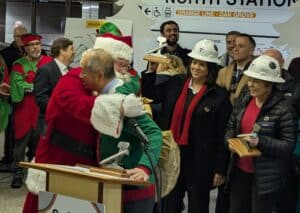
Santa Claus, played by MBTA COO Ryan Coholan, hugs MBTA General Manager Phil Eng as Gov. Maura Healey and Lt. Gov. Kim Driscoll (right and center, in white hard hats) look on. Photo by James Sanna | Banker & Tradesman Staff
Dressed in a Santa suit, MBTA Chief Operating Officer Ryan Coholan called it “a once-in-a-lifetime Christmas miracle.”
The declaration was in keeping with officials’ celebratory mood in the mezzanine of the T’s North Station subway station as they gathered for a press conference to promote the elimination of all slow zones on the MBTA subway network “for the first time in 20 years.”
The T’s workers and contractors wrapped up the last in a seemingly endless parade of shutdowns on the agency’s subway lines on Friday with a two-week closure of the Green Line from its northern termini in Somerville and Medford through to Park Street in downtown Boston.
“I want to thank the T riders for their patience and staying with us. When we came in two years ago, we said we were going to deal with this and get after it. And I really credit [MBTA General Manager] Phil Eng. Under his leadership with the team for putting together a plan to remove slow zones and take care of business,” Gov. Maura Healey said, backed by a large crowd of public officials and paperboard cut-outs of reindeer and pine trees that had been decorated with holiday lights.
The 14-month repair campaign repaired or rebuilt large sections of track on the T’s subway lines. The net effect, Healey said, has been to set riders up to save riders 2.4 million minutes “every day” that they would otherwise have wasted as their trains crawled through a section of track whose speed had been restricted thanks to a track problem that had gone too long without being repaired. Around 200 such slow zones were in place when the Healey administration took office, Lt. Gov. Kim Driscoll said.
Data from the MBTA and data independently analyzed by watchdog group TransitMatters shows MBTA work crews working overnight when trains aren’t running appear to have been effective at removing the small number of slow zones that have popped up in the last month. The T’s own tracker listed eight that had been added since Nov. 23 on the Red, Orange and Blue lines, and 12 removed by Monday morning, including two thorny ones that were eliminated by the Green Line shutdown and a long-running pair on the Red Line.
Problems Snarl Red Line During Presser
But other aging pieces of MBTA infrastructure seemed to take the opportunity Monday morning to remind officials and the public that the job of fixing decades of deferred maintenance at the agency was far from over.
Commuters on the Red Line’s Braintree branch found themselves facing delays of 20 minutes or more as they tried to head in to work Monday morning due to what the MBTA described on its account on X, formerly known as Twitter, as a “a signal problem near Braintree” followed by another at the JFK/UMass station.
The issue sent delays rippling through the rest of the Red Line. An hour after the T first announced the problem, a rider posted a photo to the Bluesky social media site showing the countdown clock on the southbound platform of the Downtown Crossing Red Line station. It listed “+50 minutes” until the next train headed towards Braintree would arrive. The agency later posted that a rail between Quincy Center and Braintree also broke in the cold, forcing northbound and southbound trains to take turns on the remaining track until it could be fixed.
“It sucks. I’m sorry. Anybody who’s waiting right now – it’s cold,” Healey said when asked by a reporter about the problems, “but, you know, we’re continuing to run a train. So from time to time, there are going to be periodic issues that come up.”
Eng told reporters that the crews began replacing antiquated signal systems on the Red and Orange lines this year, with work scheduled to be completed before the World Cup comes to Boston in 2026. The T had originally awarded a contract for the work in 2018, but Eng said his agency was speeding up the project’s delivery schedule.
The agency is also trying to upgrade its power infrastructure to make it more reliable and working with troubled train-maker CRCC to get the remainder of its new fleet of Red Line trains delivered. The current Red Line trains are some of the oldest in the country, Eng said.
“Every day, [riders] will see the system getting more and more reliable. And they will see that, from time to time, there are challenges, but you have challenges at all [transit systems],” Eng said. “The system is something I want to be proud of. I want [riders] to use this system and I want to show that we deeply care about making their lives better every day.”






